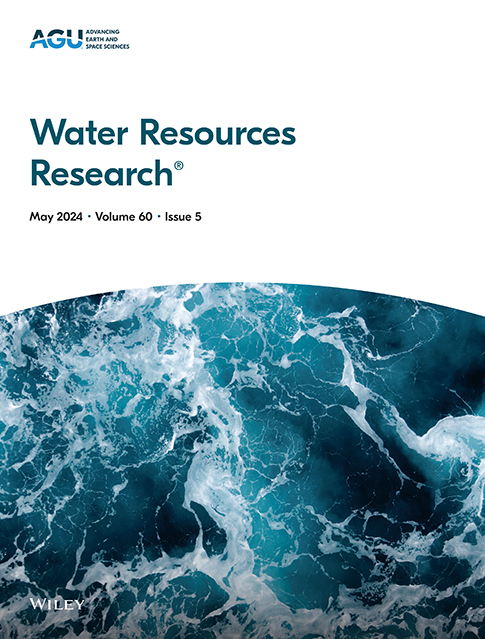Impact of Corner-Bridge Flow on Capillary Pressure Curve: Insights From Microfluidic Experiments and Pore-Network Modeling
IF 4.6
1区 地球科学
Q2 ENVIRONMENTAL SCIENCES
引用次数: 0
Abstract
The capillary pressure curve is essential for predicting multiphase flow processes in geological systems. At low saturations, wetting films form and become important, but how wetting films control this curve remains inadequately understood. In this study, we combine microfluidic experiments with pore-network modeling to investigate the impact of corner-bridge flow on the capillary pressure curve in porous media. Using a CMOS camera and a confocal laser scanning microscopy, we directly observe the corner-bridge flow under quasi-static drainage displacement, revealing that corner-bridge flow serves as an additional flow path to drain trapped water. Consequently, the capillary pressure curve shifts toward lower saturations, resulting in a reduced water residual saturation. We establish a theoretical criterion for the occurrence of corner-bridge flow and develop a pore-network model to simulate quasi-static drainage, taking into account this additional flow path. Pore-network modeling results agree well with our experimental observation. On this basis, we employ our pore-network model to systematically analyze the impact of corner-bridge flow on capillary pressure curve across varying porosity, pore-scale disorder, and system size. Results indicate that the impact of corner-bridge flow becomes more pronounced as porosity decreases and shape factor increases. Our findings demonstrate that the maximum decrease of water residual saturation is 0.19 when porosity is at its minimum, and the shape factor is at its maximum. This work bridges the gap between the pore-scale mechanism and capillary pressure behavior and has significant implications for estimating the amount of extractable water and the CO2 storage capacity.角桥流动对毛细管压力曲线的影响:来自微流体实验和孔隙网络建模的见解
毛细管压力曲线是预测地质系统多相流过程的重要工具。在低饱和度下,润湿膜形成并变得重要,但润湿膜如何控制这一曲线仍未充分了解。在本研究中,我们将微流体实验与孔隙网络建模相结合,研究了角桥流动对多孔介质中毛细管压力曲线的影响。利用CMOS相机和共聚焦激光扫描显微镜,直接观察了准静态排水位移下的角桥流动,揭示了角桥流动作为排水截留水的附加流道。因此,毛管压力曲线向低饱和度偏移,导致残余水饱和度降低。我们建立了角桥流动发生的理论准则,并建立了一个孔隙网络模型来模拟准静态排水,考虑了这一额外的流动路径。孔隙网络模拟结果与实验结果吻合较好。在此基础上,利用孔隙网络模型系统分析了不同孔隙度、孔隙尺度无序度和系统尺寸下角桥流动对毛管压力曲线的影响。结果表明,随着孔隙率的减小和形状因子的增大,角桥流动的影响更加明显。研究结果表明,孔隙度最小时残余水饱和度降幅最大,为0.19,形状因子最大;这项工作弥补了孔隙尺度机制和毛细压力行为之间的差距,并对估计可提取水量和二氧化碳储存能力具有重要意义。
本文章由计算机程序翻译,如有差异,请以英文原文为准。
求助全文
约1分钟内获得全文
求助全文
来源期刊

Water Resources Research
环境科学-湖沼学
CiteScore
8.80
自引率
13.00%
发文量
599
审稿时长
3.5 months
期刊介绍:
Water Resources Research (WRR) is an interdisciplinary journal that focuses on hydrology and water resources. It publishes original research in the natural and social sciences of water. It emphasizes the role of water in the Earth system, including physical, chemical, biological, and ecological processes in water resources research and management, including social, policy, and public health implications. It encompasses observational, experimental, theoretical, analytical, numerical, and data-driven approaches that advance the science of water and its management. Submissions are evaluated for their novelty, accuracy, significance, and broader implications of the findings.
 求助内容:
求助内容: 应助结果提醒方式:
应助结果提醒方式:


